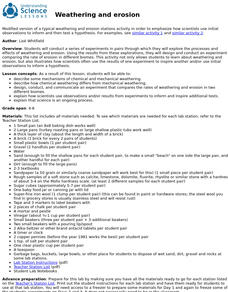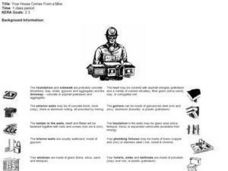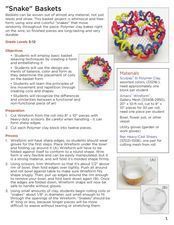Science Matters
Seed Adaptations for Dispersal
After a grand conversation about seeds, adaptation, and dispersal, scholars work collaboratively to examine seeds and record their findings on a four-column chart. Small groups share their observations and further discuss seed...
Reading Through History
The Fugitive Slave Act of 1850
Why was the Fugitive Slave Act of 1850 so important? The reading in the resource discusses how the act affected Southerners, Northerners, and the slaves themselves. Scholars complete the reading as a form of direct instruction while...
Purdue University
Design of an Earthen Dam for a Lafayette Neighborhood
How do dams support bodies of water? Scholars engage in a hands-on STEM activity where they design, build, and test dams to learn about bodies of water and how humans use natural resources. They learn how criteria and constraints affect...
Syracuse University
Ancient World Writing System
Most twenty-first century pupils don't know how to interpret cuneiform. Examining images of cuneiform and papyrus writing and using a chart and Venn diagram, young historians extrapolate what life may have been like for people who lived...
University of California
Weathering and Erosion
Just how powerful is erosion? Interested scientists learn how to identify the results of erosion with a series of lab activities. They move through stations to experiment with different types of erosion and then design and complete their...
NOAA
Climate Is Our Friend…Isn’t It?: Make an Extinction Polyhedron
Climate affects populations in different ways. Scholars research extinct organisms and mass extinctions in part three of the 10-installment Discover Your Changing World series. They create graphic organizers, then fill in the...
Teaching Tolerance
Identity Artifacts Museum
Who are you? It's a simple question, but younger learners have the opportunity to express their complex identities by making artifacts that represent parts of their identities. After engaging in the activity, they share who they are with...
American Museum of Natural History
Piecing It All Together
Archaeology digs are much like giant jigsaw puzzles. The artifacts found are often in pieces and scientists must reconstruct them. A hands-on activity lets young archaeologists experience this facet of the job as they create, smash, and...
American Institute of Physics
African American Inventors in History
A two-part lesson introduces young historians to the work of famous African American inventors. Groups first research and develop a presentation of an inventor that includes biographical information and information about one of their...
K12 Reader
Yeats and the Poetry of Ireland
W.B. Yeats' poem, "The Lake Isle of Innisfree" is featured on a worksheet that asks readers to respond to a series of reading comprehension questions.
Curated OER
Let's Celebrate Diwali!
Students utilize several short readings to investigate a variety of multicultural celebrations. The two key celebrations of Diwali and the Festival of Lights provide the background for the exploration.
Curated OER
Inuit Sculpture
Kids in grade four through eight research Inuit artists and art styles. After a critical look at Inuit sculpture, they use those forms for inspiration as they create one of their own. They practice using the subtractive method of...
Curated OER
Soil's Secret
Learners examine two types of soils in their area. They identify its texture and permeability to determine its origin. They share their results with the class.
Curated OER
Smoking Danger Demonstration
Students watch a demonstration to show the harmful effects of smoking. During the demonstration, they discover how tar and nicotine attaches itself to the lungs. They write a brief summary of the demo and what information they gathered...
Curated OER
Your House Comes from a Mine
What do your learners know about mining? Invite them to read about all of the materials that come from mining that go into building a house. Additionally, they answer four questions at the bottom of the instructional activity.
Curated OER
An Organic Work That Imitates Life
Students practice using organic and geometric forms while creating individual works of art. This creative art lesson plan incorporates Math concepts for a cross-curricular approach in the classroom.
Curated OER
Ball and Triangle Game
Students view and discuss pictures of the Ball and Triangle Game the Penobscot Indian students in New England played. They construct cardboard versions of the game, and practice the game and keep score using beans.
Curated OER
Medieval Art
Sixth graders study Gothic architecture on the Internet and create a mug with a gargoyle figure on it.
Curated OER
Shoe Shine
Young artists use Paintstik colors on paper, canvas, metal, fabric or another surface to create a work of art to be presented in a gallery. Young scholars research the origins of the "Snakebasket" they are creating. These art lessons...
Curated OER
Gift for the Indians: Model of the Mayflower in the Ocean
Students build a miniature replica of the Mayflower. They make the boat float in a cup of water while studying the concept of gift giving on Feast Day.
Curated OER
Minoan Pottery - A History Lesson
Accent your next ancient pottery art project with easy-to-follow background information. An article describes the background, significance, and history of Minoan Pottery. It includes links to images, sites and ideas. Tip: This is a great...
Curated OER
Reaching Your Potential - Personal Development
How do young people know the potential they possess? Middle schoolers explore their personal potential through two different activities and a class discussion. They examine where their aptitudes lie, and how they can use their gifts to...
Curated OER
Mechanics and Supplies
Flower arrangements and the types of containers used to hold them, is the subject of this slideshow. There is detailed, relevant information about many aspects of the tools used, and each slide is clear with a header and short...
Curated OER
Animal Habitat Dioramas
What a better way to have learners show what they know than with a diorama? Kids research an animal, its habitat, ecosystem, and environment in order to create a three-dimensional diorama. Have older children write a short paper on their...
Other popular searches
- Clay Animation
- Clay Sculpture
- Claymation
- Clay Projects
- Clay Art
- Ceramics, Clay
- Clay Relief Sculpture
- Clay Construction Techniques
- Air Dry Clay
- Clay Modeling
- Clay Pottery
- Clay Masks

























